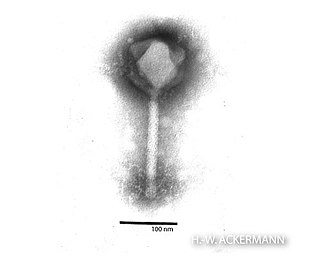
Podoviridae is a family of bacteriophage in the order Caudovirales often associated with T-7 like phages. There are 130 species in this family, assigned to 3 subfamilies and 52 genera. This family is characterized by having very short, noncontractile tails. Podoviradae are largely understudied and most new isolates are of the phicbkviruses genus, a group of giant viruses that appear to be Caulobacter specific.

Halspiviridae is a family of viruses that consists of a single genus, Salterprovirus, which consists of a single recognised species; Salterprovirus His1. This virus was isolated from hypersaline water in Australia and was able to be cultured on the halophilic archaeon Haloarcula hispanica. Like many other archaeoviruses, His1 has an approximately limoniform (lemon-shaped) virion.
Uetakevirus is a genus of viruses in the order Caudovirales, in the family Podoviridae. Bacteria serve as natural hosts. There are three species in this genus. These phages are temperate and infect Salmonella and Escherichia coli.
Punavirus is a genus of viruses in the order Caudovirales, in the family Myoviridae. Bacteria serve as natural hosts. There are four species in this genus.
Peduovirus is a genus of viruses in the order Caudovirales, in the family Myoviridae, in the subfamily Peduovirinae. Bacteria serve as natural hosts, with transmission achieved through passive diffusion. There are 15 species in this genus.
Tequatrovirus is a genus of viruses in the order Caudovirales, in the family Myoviridae, in the subfamily Tevenvirinae. Gram-negative bacteria serve as the natural host, with transmission achieved through passive diffusion. There are 75 species in this genus.
Felixounavirus is a genus of viruses in the order Caudovirales, in the family Myoviridae. Bacteria serve as natural hosts, with transmission achieved through passive diffusion. There are currently 16 species in this genus, including the type species Salmonella virus FelixO1.
Muvirus is a genus of viruses in the order Caudovirales, in the family Myoviridae. Bacteria serve as natural hosts, with transmission achieved through passive diffusion. There are two species in this genus.
Lubbockvirus is a genus of viruses in the family Myoviridae, not assigned to a subfamily. Bacteria serve as the natural host, with transmission achieved through passive diffusion. There are two species in this genus.
Myohalovirus is a genus of viruses in the order Caudovirales, in the family Myoviridae. Bacteria and archaea serve as natural hosts. There are three species in this genus.

Phikzvirus is a genus of viruses in the order Caudovirales, in the family Myoviridae. Bacteria serve as natural hosts. There are three species in this genus.

Teseptimavirus is a genus of viruses in the order Caudovirales, in the family Autographiviridae, in the subfamily Studiervirinae. Bacteria serve as the natural host, with transmission achieved through passive diffusion. There are currently 17 species in this genus, including the type species Escherichia virus T7.
Salasvirus is a genus of viruses in the order Caudovirales, in the family Salasmaviridae, in the subfamily Picovirinae. Bacteria serve as natural hosts. There are four species in this genus.
Lambdavirus is a genus of viruses in the order Caudovirales, in the family Siphoviridae. Bacteria serve as natural hosts, with transmission achieved through passive diffusion. There are five species in this genus. The genus also includes several unclassified viruses—including the corynephages β and ω, which infect Corynebacterium diphtheriae and carry the deadly diphtheria toxin.
Ravinvirus is a genus of viruses in the order Caudovirales, in the family Siphoviridae. Bacteria serve as natural hosts, with transmission achieved through passive diffusion. There is only one species in this genus: Escherichia virus N15.
Lomovskayavirus is a genus of viruses in the order Caudovirales, in the family Siphoviridae. Bacteria serve as natural hosts. There are two species in this genus.
Tequintavirus is a genus of viruses in the order Caudovirales, in the family Demerecviridae. Bacteria serve as the natural host, with transmission achieved through passive diffusion. There are currently 22 species in this genus, including the type species Escherichia virus T5.
Tunavirus is a genus of viruses in the order Caudovirales, in the family Drexlerviridae. Bacteria serve as natural hosts. There are currently 14 species in this genus, including the type species Escherichia virus T1.
Bullavirinae is a subfamily of viruses in the family Microviridae. Enterobacteria serve as natural hosts. There are 14 species in this subfamily, organized into three genera.
Thaspiviridae is a family of spindle-shaped viruses that is not assigned to any higher taxonomic ranks. The family contains a single genus, Nitmarvirus, which contains a single species, Nitmarvirus NSV1.



